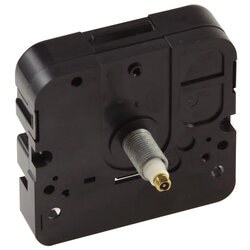Don't wanna be here? Send us removal request.
Text
Digital Clock Movements versus Mechanical Ones

Digital clock movements are modern engines, as it were, or motors that consistently place the hands for accurate time informing. Mechanical clock movements are their predecessors, using gears and numerous devices to revolve the hands right into area. The standard display was analog hands superimposed over a dial, whereas electronic displays might be analog or digital, utilizing LEDs.
Thus, clock movements execute the same function, whether digital or mechanical, and they often look primarily the like well. Nonetheless, the innards of the two types are rather various, with the mechanical motors employing hanging weights or coiled springtimes as their force, converting prospective energy right into kinetic by rotating a flywheel. Rate of turning was managed with using a pendulum and escapement device.
On the other hand, the force behind the digital movement is quite various, basically applying a change in voltage throughout a quartz crystal, which responds by rapidly shaking at a certain powerful regularity. It is fairly uncomplicated to keep track of the resonances and count their pulsing in real time. Since the vibrating regularity is so exact, the gathered pulse matter (kept in digital signs up) is a very accurate step of elapsed time.
However, since the running number of pulses is a lot greater than the number of secs passed, software has to be set up to partition the total amount to the 2nd array and kept in a separate register. (Mechanically, the mix of pendulum and escapement guarantees a rotational modification of one tick per second.) Either mechanically or online, with the passing away of every second the clock movement subtends the pre-owned an extra six levels of arc.
More registers monitor mins and hours, each ticking up by one when the previous register reaches sixty. Going across the minute limit causes the equivalent hand to get revolved a tick, and the hour hand gets revolved at one-twelfth that rate. The hands will certainly all align once again when the duration is gotten to.
One of the most typical period is twelve hours (resetting two times a day), yet movements with longer durations are likewise offered. Of note are periods of 24 hr, 1 week, 1 month, and 24-hour plus 50 minutes (representing the lunar cycle for tracking trend level). Many of these require an extra hand and a dial calibrated to the movement.
For example, the weekly period utilizes a dial with the names of the 7 days radiating out from the facility for concerning half the dial distance. The added hand rotates regarding 51.4 ° at midnight to indicate the next day. The other special time-extended movements utilize similar hand and dial plans.
Digital clock movements can being reconfigured to track and show specific weather phenomena such as regional humidity, temperature, or barometric pressure. These things aren't routine, and sensors need to be utilized to register changing dimensions in real time. The dial is essentially a range arching from one end to the various other around the dial circumference, and the single hand is turned to the mark corresponding to the measured value.
There are (or at least have been) mechanical movements for tracking weather occasions also, but they often tend to be more troublesome than their electronic counterparts. This is since thoroughly developed tools have to be built to map analyses right into hand setting, whereas electronically the entire process is taken care of in software.
We have concentrated on timekeeping functions, yet both sort of motors are capable of featuring uniqueness such as playing chimes or oscillating pendulums. They differ in terms of approach but the effect is basically the same. These tools have been around in some type for centuries, and it can be beneficial to have an understanding of just how electronic clock movements run versus mechanical ones.
clock parts
youtube
1 note
·
View note